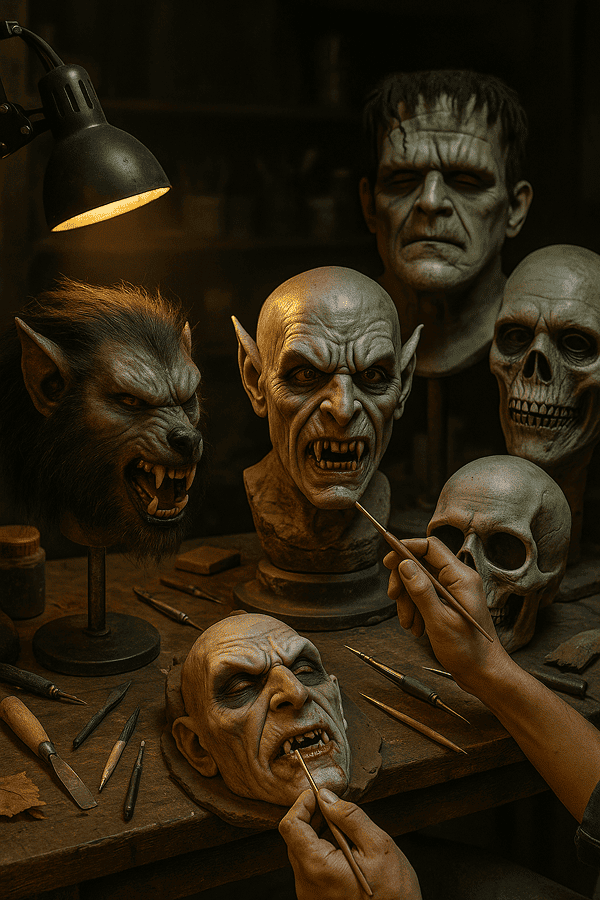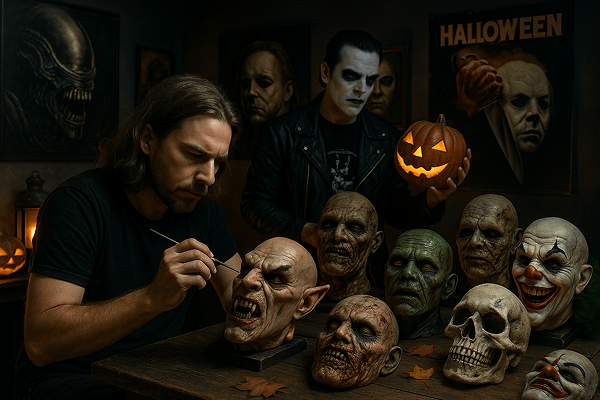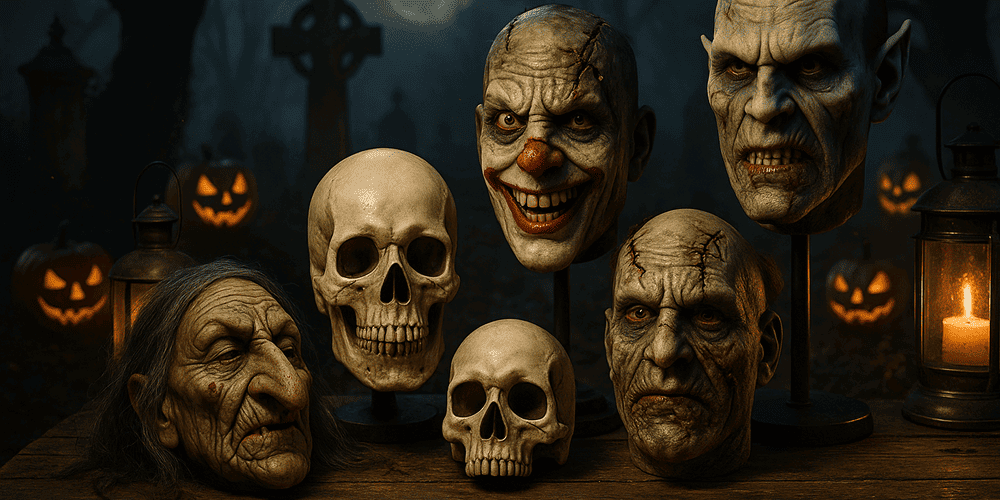Halloween Horror Masks are among the most iconic and visually striking elements of modern Halloween celebrations. Designed to frighten, amuse, and transform, these masks often depict classic monsters, supernatural beings, and grotesque faces — from vampires and zombies to twisted clowns and demonic entities. Commonly made of latex, silicone, or plastic, Halloween Horror Masks stand out for their hyper-realistic features: exaggerated fangs, rotting flesh, gory wounds, and glowing eyes. Their primary home is in North American and European Halloween festivities, but their popularity has spread globally since the late 19th and especially the 20th century, becoming a symbol of both popular culture and the art of fright.
Historical Origins of Halloween Horror Masks
The roots of Halloween Horror Masks lie in ancient Celtic traditions, particularly the festival of Samhain, when people would wear masks or costumes to ward off wandering spirits at summer’s end. The term “Halloween” itself evolved from “All Hallows’ Eve,” marking the night before All Saints’ Day. As the holiday migrated to North America, it absorbed influences from European masquerades and American popular culture.
The word “horror” comes from the Latin “horrere,” meaning “to bristle” or “shudder,” reflecting the desired effect of these masks. In the early 20th century, the rise of horror cinema and pulp fiction introduced new imagery — Frankenstein, Dracula, the Mummy, the Wolfman — which quickly became staples of Halloween horror iconography. Early masks were made of papier-mâché or cloth, but the invention of latex in the 1920s and 1930s revolutionized mask-making, allowing for greater detail and mass production.
Notable historical references include classic Don Post Studios masks of the 1960s, which set the standard for realistic horror masks, and early Universal Monsters masks. These artifacts now appear in museum collections and private displays, marking milestones in the evolution of Halloween Horror Masks.
Cultural Significance and Symbolism of Halloween Horror Masks
Halloween Horror Masks are rich in symbolism, embodying society’s fascination with fear, the supernatural, and the unknown. In their native cultures, they serve as a playful means of confronting and processing anxieties about death, evil, and the afterlife. Masks such as skulls, witches, and ghouls symbolize transformation and the blurring of the line between the living and the dead.
Spiritually, these masks echo ancient beliefs about the power of disguise to protect against spirits or to channel otherworldly forces. Socially, they enable wearers to step into roles they would never assume in daily life — the monster, the villain, the outsider — and to participate in communal rituals of inversion and release. Myths and legends, from the Headless Horseman to urban tales of haunted masks, have only deepened their cultural resonance.
The context of use is often playful and communal, found in trick-or-treating, haunted houses, and Halloween parties. The mask, therefore, becomes a tool for both individual expression and collective catharsis.
Materials and Crafting Techniques of Halloween Horror Masks
The most common materials for Halloween Horror Masks are latex, silicone, vinyl, plastic, and, increasingly, advanced polymers and 3D-printed composites. Traditional handmade masks may also use papier-mâché, fabric, or even carved wood. The process typically begins with sculpting an original design in clay, then creating a mold for casting the mask material.
Special techniques include hand-painting, airbrushing, application of artificial hair, and embedding of LED lights for glowing effects. Artists use sculpting tools, brushes, airbrush equipment, and sometimes digital sculpting programs for prototype design. Some masks are mass-produced, while others are hand-finished or custom-made by independent artisans.

Regional differences exist: American and European masks often emphasize pop culture monsters and movie villains, while Japanese horror masks may draw on yokai and kabuki traditions. Color symbolism is crucial: reds for blood and violence, greens and grays for decay, blacks for mystery and fear, and white for spectral or ghostly themes. Decorative elements like scars, wounds, and fangs enhance the horror aesthetic.
For more on mask-making traditions and interviews with artists, visit toddmasks.com.
Functions and Uses of Halloween Horror Masks
The primary function of Halloween Horror Masks is to frighten, entertain, and transform. Ritual use has faded, but the mask’s power to invert social roles and unleash hidden aspects of the self remains central. They are worn during trick-or-treating, haunted attractions, costume contests, and Halloween parties.
Theatrically, horror masks are used in stage productions, immersive theater, and film, where they help actors embody monsters and supernatural beings. In festivals and parades, masks are a focal point for communal celebration and spectacle. Over time, their use has expanded to include horror conventions, cosplay events, and even art installations.
In contemporary society, Halloween Horror Masks are also used for social commentary, parody, and satire, lampooning political figures or critiquing current events. Their enduring popularity is a testament to their adaptability and cultural resonance.
Regional Variations of Halloween Horror Masks
While North America is the epicenter of the modern Halloween Horror Mask tradition, regional variations abound. In the United Kingdom, masks often emphasize classic gothic and folk motifs. In Mexico, Día de los Muertos masks blend horror and reverence, featuring skulls with festive designs. Japanese horror masks are inspired by folk demons and spirits, while European traditions may incorporate witch, vampire, and werewolf themes.
Unique local features might include the use of traditional materials, incorporation of regional folklore, or adaptation of popular horror movie characters. Comparing Halloween Horror Masks to other Halloween Masks and global ceremonial masks reveals both shared roots and distinctive local adaptations.
Famous Examples and Notable Collections of Halloween Horror Masks
Some of the most famous Halloween Horror Masks are iconic movie props: the Michael Myers mask from “Halloween,” the hockey mask from “Friday the 13th,” and the Ghostface mask from “Scream.” Vintage Don Post and Distortions Unlimited masks are highly collectible, often displayed in museums such as the Museum of Pop Culture (MoPOP) in Seattle.
Private collectors and horror enthusiasts often curate extensive collections of rare, artist-signed, or screen-used masks. Temporary exhibitions and mask festivals allow the public to appreciate the diversity and artistry of these creations. For curated galleries and expert commentary, toddmasks.com provides digital showcases of significant Halloween Horror Masks.
Influence of Halloween Horror Masks on Art and Culture
Halloween Horror Masks have profoundly influenced visual art, cinema, fashion, and music. Their imagery is central to horror films, graphic novels, and video games. Artists like H. R. Giger and Rick Baker have set new standards for mask design in Hollywood. In music, horror-themed bands and performers use masks for dramatic effect and stage persona.

In literature, masks symbolize hidden identity, transformation, and fear. In fashion, horror motifs inspire everything from haute couture to streetwear, especially during the Halloween season. The preservation and celebration of Halloween Horror Masks are vital for maintaining the cultural legacy of the holiday and its artistic potential.
Contemporary Status and Preservation of the Halloween Horror Mask Tradition
Today, the tradition of creating and wearing Halloween Horror Masks thrives. Master sculptors and independent studios produce limited editions, custom orders, and licensed movie replicas. Educational programs, online tutorials, and maker communities encourage new generations to explore mask-making.
Modern innovations include 3D printing, eco-friendly materials, and augmented reality (AR) masks for digital celebrations. Halloween conventions, workshops, and mask contests keep the tradition vibrant. Organizations like toddmasks.com support the preservation, teaching, and evolution of Horror Mask artistry.
Collecting and Acquiring Halloween Horror Masks
The collector’s market for Halloween Horror Masks is dynamic, ranging from affordable store-bought masks to high-value vintage or artist-signed pieces. Authentic masks can be found through specialized retailers, reputable online platforms like toddmasks.com, auctions, and conventions.
Key factors influencing value include material, rarity, age, association with famous films, and artist reputation. Provenance and documentation add value, while mass-produced or counterfeit masks are less desirable. Ethical collecting means supporting original artists and respecting copyright and cultural heritage.
